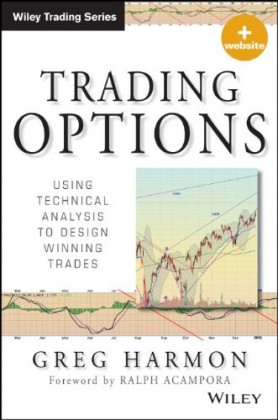 My friend Greg Harmon is a trader’s trader, a real guy who actually does this for a living and not as a role-playing exercise on Twitter. I’ve known Greg for a few years and have been reading his excellent blog Dragonfly Capital for the last three or four years.
My friend Greg Harmon is a trader’s trader, a real guy who actually does this for a living and not as a role-playing exercise on Twitter. I’ve known Greg for a few years and have been reading his excellent blog Dragonfly Capital for the last three or four years.
Greg’s a technician by training and even though he runs a paid service, he’s insanely generous with the trading setups and ideas he puts out there for free each day. Even though not everything he writes has an immediate application for longer-term investors like myself, I almost always find something new or educational from his stuff – regular readers here know that I link to Dragonfly often in Hot Links.
Greg has a new book out called ‘Trading Options’ that I’m excited to tell you about. It’s about how he uses technical analysis to trade options and which strategies work best for different trading ideas and timeframes. There are immediately applicable lessons in here for traders of all levels, for those looking to learn the basics of options / technical strategy or for pros looking to add some new tools to their repertoire. I asked Greg to answer four questions the other night to give people a sense of what the book covers. I hope you enjoy this interview.
– JB
***
1. What’s your background and why did you decide you wanted to do this book?
I have been trading in the markets since 1986 starting with short term money markets and moving into equities and options in the mid 1990’s. At the time of the financial crisis I was trading equity derivatives for hedge fund clients and that business dried up fast putting me on the street. I decided to go on my own then and created Dragonfly Capital. I bared my process to all on social media posting ideas on 100’s of stocks each weekend and about 50 each night. I was content at first to post charts of what I was watching and answer but soon needed to express my thoughts in more than 140 characters and started blogging. Questions would come in about the ideas and the process and I realized from them that most ‘traders’ on social media had no formal experience trading and that there was an opportunity to help others. As time went on and the number of new traders kept increasing it got harder and harder to cover the basics of the process and trade for myself and clients. I loved the interaction with new traders but determined that to get a base level of understanding it made sense to memorialize my process, thus the book. The book is about my process, from top down macro technical analysis and intermarket relationships to single stock selection and development of options trades to apply to them in a controlled framework.
2. How many years of experience as a trader should one have before attempting to focus primarily on options.
The skill and experience required to focus more time on options depends on the strategies used. For some simple strategies, like deep in the money call or put buying, it is not very different from straight stock trading. Except that you can limit the capital at risk. Many with very little experience do trade options in high priced stocks like Apple, Google or Priceline. And for a basic stock replacement strategy using options, it may make sense for more to trade this way instead of using stocks. There are nuances though. Options expire, so longer dated deep in the money options make more sense when trading a stock replacement. But for something like a combination strategy where you are using margin, involving selling naked puts or calls, you should have a good understanding of time value and be well versed at hedging. This will obviously be a different learning curve for everyone. I do not think it makes sense as an individual to ever focus solely on options. I do a lot of options trading but also a good deal of trading in straight equities, mostly for longer holding periods. Start with a solid long term stock base to your portfolio and look to adding options for the portion that is shorter term in horizon.
3. The benefits of options are that your risk can be controlled and finite while your reward can be leveraged when you pick a winning trade. But timing becomes really crucial with options and it is not on your side. Why is this tradeoff worthwhile? Are there specific instances in which you’ll not use options for a given set-up?
There is so much in this question. Let me start with when I would not use options. If I like a stock and want to own it for a long horizon I would just buy the stock unless both capital was scarce and the stock paid little or no dividend. Options can still be used to trade around the stock to create income, but the time decay makes it better to own the stock outright. It also does not make sense to trade options on a stock if the liquidity (either from measuring the bid /offer spread, or the volume or both) is not adequate. Believe it or not there are plenty of active stocks with options where only a handful of contracts trade daily.
Yes, options can be used to control risk, and provide leverage. Controlling risk can mean a lot of things to different people. For options it most importantly means limiting capital at risk. If you buy a put or a call or a spread or a Butterfly for $1.00 then $1.00 is all that you can lose. Period. For many short term trades the cost of an option can be less than the amount you would risk with a stop loss on the stock, and remember your stop loss will not trigger immediately as the stock you hold gaps down in pre-market trading on news. You can lose a lot more than the stop loss.
Leverage in directional trades is the enticing aspect of options to many traders. But you are right that you can lose in options just because time passes, if the stock does not move. You need stop losses on options just like on stocks to manage this risk. But outside of simple call and put buying for directional trades, there are also strategies like Calendars and Diagonals, that allow you to win even if the stock does not move or moves against you. They can sound complicated but when they are broken down into the component pieces, they are easy to understand. Determining a Driver for the trade, the 1 option that you really want to own, is the key and then using building blocks of other puts or calls at different strikes and expirations to control risk and add leverage where appropriate, complete the trade, no matter what you end up calling it. This is what the options portion of the book is about.
The bottom line is that options allow a lot of flexibility in designing a trade around a stock. They will always help manage risk and increase leverage, but the trader needs to understand that the additional component of time also needs to be managed.
4. What would you say is the number one misconception about technical analysis? Are there critics and devotees of fundamental analysis who are using some elements of technical analysis without even realizing it?
This one is easy. Most traders or investors that criticize technical analysis do so because they assume that the result of the analysis is a roadmap, a direction with certainty. It is nothing of the sort. Technical analysis is about the possibility. Technical analysts and traders will draw all sorts of lines and spout off support and resistance levels that appear to be full of certainty. Their analysis is not about identifying points of certainty but rather points of reflection, where price history has shown a price level important and so might make it important again. Might. Technical analysis encompasses many different styles of analysis. Pattern recognition gets the most attention but things like sentiment measures, quantitative analysis and seasonality are also part of technical analysis. “Sell in May and go away” has technical analysis at its roots. Technical analysis is really just the study of supply and demand for securities. If more fundamentally bent analysts understood it this way there would likely be much greater acceptance.
***
Thanks Greg!
Follow Greg Harmon on Twitter @harmongreg
Greg’s blog is here: Dragonfly Capital
Buy the book today:
Trading Options: Using Technical Analysis to Design Winning Trades (Wiley Trading)




how to use ben wa balls
[…]usually posts some quite intriguing stuff like this. If youre new to this site[…]
consulenze hacker
[…]please stop by the sites we adhere to, such as this 1, as it represents our picks from the web[…]
best rabbit vibrators
[…]just beneath, are many completely not associated web sites to ours, on the other hand, they’re certainly worth going over[…]
lesbian massager
[…]below you will uncover the link to some sites that we feel you’ll want to visit[…]
how do lesbians have sex
[…]Here is a great Blog You might Uncover Fascinating that we Encourage You[…]
oh naughty rabbit vibrator
[…]one of our guests recently advised the following website[…]
mp3 songs
[…]usually posts some very exciting stuff like this. If youre new to this site[…]
how do lesbians have sex
[…]Here are a few of the web sites we suggest for our visitors[…]
aflampornhd
[…]check below, are some absolutely unrelated sites to ours, having said that, they’re most trustworthy sources that we use[…]
adult tube websites
[…]always a big fan of linking to bloggers that I like but do not get a whole lot of link enjoy from[…]
best sex toys
[…]just beneath, are various entirely not associated websites to ours, having said that, they may be certainly really worth going over[…]
Pet Painting
[…]one of our visitors not long ago advised the following website[…]
tounge vibrators
[…]The details talked about within the article are a number of the top offered […]
bullet vibrator
[…]check beneath, are some completely unrelated web sites to ours, nonetheless, they are most trustworthy sources that we use[…]
remote control vibrating egg
[…]we prefer to honor several other web sites around the net, even though they arent linked to us, by linking to them. Beneath are some webpages worth checking out[…]